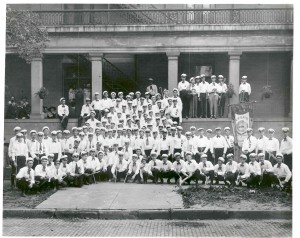Ward M. Canaday Center Preserves Toledo Economic History
By Barbara Floyd, director, Ward M. Canaday Center for Special Collections
 For University of Toledo alumni of a certain era, the names Tiedtke’s, Toledo Scale, Willys-Overland, and Champion Spark Plug hold warm memories. Perhaps more than a few UT graduates earned their way through college by working for these companies, while others may have had life-long careers with them. In addition to these company names that are no longer, there are others businesses and industries that have been a part of our past that are still part of our future, like Owens-Illinois, Owens Corning, and Dana. Together, these companies define our community, and are “wholly Toledo.”
For University of Toledo alumni of a certain era, the names Tiedtke’s, Toledo Scale, Willys-Overland, and Champion Spark Plug hold warm memories. Perhaps more than a few UT graduates earned their way through college by working for these companies, while others may have had life-long careers with them. In addition to these company names that are no longer, there are others businesses and industries that have been a part of our past that are still part of our future, like Owens-Illinois, Owens Corning, and Dana. Together, these companies define our community, and are “wholly Toledo.”
The Ward M. Canaday Center for Special Collections collects, preserves, and makes available historical materials that document the history of our city and region. For the past 20 years, a special focus of the center has been on collecting materials that document Toledo’s rapidly changing economy. By collecting and preserving these materials, the center helps to ensure that our city’s rich history is not forgotten. These unique collections are also utilized by scholars from around the world to produce original research, and provide valuable learning opportunities for UT students.
 Since the early 20th century, Toledo has been known as the Glass Capital of the World. And today, the Canaday Center preserves the most important collection of records documenting this industry in the world. The center houses the historical records of Libbey-Owens-Ford (now Pilkington North America), Owens-Illinois, and Owens Corning. Over 500 boxes of historical materials document how Michael Owens developed the automatic bottle machine, how a new method for producing flat glass invented by Irving Colburn was perfected by Owens and Edward Drummond Libbey, and how a new product called Fiberglas was invented when excess bottle-making capacity during Prohibition made Owens-Illinois look for another product to market.
Since the early 20th century, Toledo has been known as the Glass Capital of the World. And today, the Canaday Center preserves the most important collection of records documenting this industry in the world. The center houses the historical records of Libbey-Owens-Ford (now Pilkington North America), Owens-Illinois, and Owens Corning. Over 500 boxes of historical materials document how Michael Owens developed the automatic bottle machine, how a new method for producing flat glass invented by Irving Colburn was perfected by Owens and Edward Drummond Libbey, and how a new product called Fiberglas was invented when excess bottle-making capacity during Prohibition made Owens-Illinois look for another product to market.
 The glass-related collections have been used by many kinds of researchers. Architectural scholars have used the L-O-F collection to study how structural glass made possible the construction of skyscrapers. Historians have used the collection to research how the automobile industry adopted safety glass. Glass bottle collectors have utilized old catalogs in the Owens-Illinois collection to research the dates and values of items in their collections. This semester, students from UT Department of History classes will be using the collections to learn historical research skills and expand their knowledge of Toledo history.
The glass-related collections have been used by many kinds of researchers. Architectural scholars have used the L-O-F collection to study how structural glass made possible the construction of skyscrapers. Historians have used the collection to research how the automobile industry adopted safety glass. Glass bottle collectors have utilized old catalogs in the Owens-Illinois collection to research the dates and values of items in their collections. This semester, students from UT Department of History classes will be using the collections to learn historical research skills and expand their knowledge of Toledo history.
In addition to the glass industry, the Canaday Center also preserves records documenting the history of Toledo Scale, the Dana Corporation, Acklin Stamping, The Andersons, the Lion Dry Goods Company, and many others. Last year, the center produced a major original exhibition entitled “Wholly Toledo: The Business and Industry that Shaped the City” that allowed the public to see some of the rare items in the collections. These included the original drawing by Clarence Spicer for a universal joint that formed the foundation for the Dana Corporation, a film that showed Michael Owens overseeing production from an early version of his bottle machine, and the recipe for Huebner Beer from the Huebner Brewing Company.
For those who may have missed the exhibit, an on-line virtual version can be accessed at: http://libraryexhibits.utad.utoledo.edu/WTX/index.html
 In 1872, Toledo real estate broker Jesup W. Scott wrote an essay calling Toledo “The Future Great City of the World.” To help to realize this dream, Scott founded a university to train Toledo’s young people to assume productive roles in this future great city which became the University of Toledo. While Scott’s vision may have fell short, the records of Toledo’s industrial and commercial development that are preserved in the Canaday Center are evidence that the city has much to be proud of in its past—and its future.
In 1872, Toledo real estate broker Jesup W. Scott wrote an essay calling Toledo “The Future Great City of the World.” To help to realize this dream, Scott founded a university to train Toledo’s young people to assume productive roles in this future great city which became the University of Toledo. While Scott’s vision may have fell short, the records of Toledo’s industrial and commercial development that are preserved in the Canaday Center are evidence that the city has much to be proud of in its past—and its future.
The Canaday Center’s next exhibition is titled “Medicine on the Maumee: A History of Health Care in Northwest Ohio.” The free, public exhibit opens March 1 at 3 p.m. with a presentation on early medicine in the region by historical interpreter John Jaeger, who will portray “The Black Swamp Doctor.” The exhibit will be on display Monday through Friday, 8 a.m. to 5 p.m. and by appointment in the Canaday Center, located on the fifth floor of the William S. Carlson Library. For more information, contact the Canaday Center at 419-530-2170.






